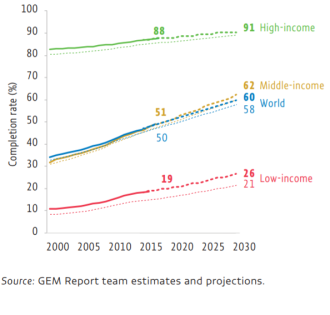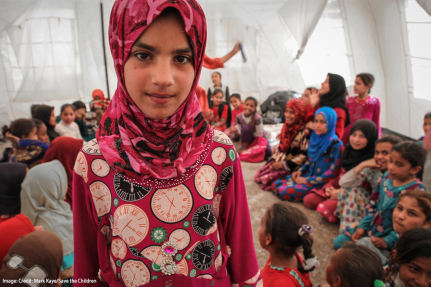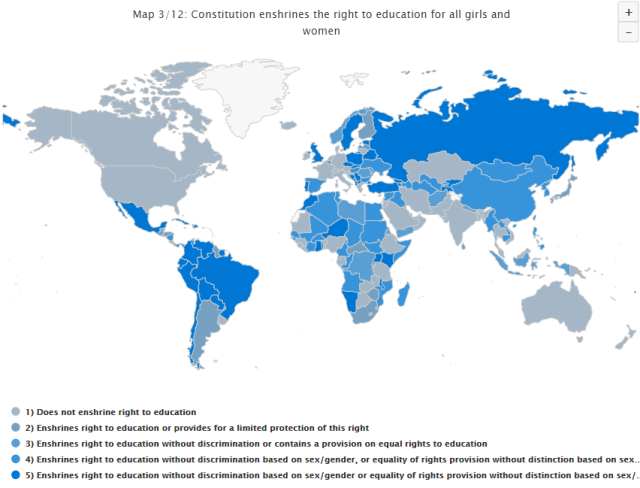Why completion rates should be part of the SDG global indicator framework
By Silvia Montoya, Director of the UNESCO Institute for Statistics, and Manos Antoninis, Director of the Global Education Monitoring Report
The clock is ticking, with just over a decade to ensure that every child, adolescent and youth completes primary and secondary education of quality.
The good news is that the global primary completion rate has been steadily rising from 70% in 2000 to an estimated 84% in 2018. If current trends continue, the rate will reach 89% by 2030, according to recent projections by the UNESCO Institute for Statistics (UIS) and the Global Education Monitoring Report (GEMR), and 93% allowing for those who are going to complete primary school very late. By accelerating this rate of growth, we can still achieve universal primary completion by 2030.
Figure 1. Upper secondary completion rates, 2000-2018, and projections to 2030

Unfortunately, the same cannot be said for secondary education (see Figure 1). Without a major transformation in education, only six in ten young people will be completing secondary school in 2030.
While our projections sent a shockwave throughout the international community, we must keep up the pressure by regularly reporting on education completion at the global, regional and country levels.
This is why the UIS, as custodian agency for SDG 4 data, has proposed that the Inter-agency and Expert Group on SDG Indicators (IAEG-SDGs) include completion rates within the global monitoring framework with the aim of offering a more informed view of progress towards target 4.1. This proposal was based on consultation with the Technical Cooperation Group on the Indicator for SDG 4 (TCG) in 2017.
There are several reasons for the proposal. By raising the profile of the indicator, we can highlight the urgency for action across the UN system. For example, as a global monitoring indicator, completion rates would be included in the annual SDG progress reports. Accordingly, the recent meeting of the TCG in Yerevan, Armenia, endorsed the completion rate as one of the indicators for which to define reference points for progress at the global and regional level.
The Technical Cooperation Group has also requested available data to be used more efficiently to calculate the completion rate. This will build on the lessons learned from other flagship indicators that rely on multiple sources, such as child mortality rates.
Critically, we can combine the completion rate with learning outcome indicators to offer a more comprehensive and accurate perspective on progress towards target 4.1, as shown in a new UIS paper. Continue reading →
Like this:
Like Loading...
 The first regional edition of the Global Education Monitoring (GEM) Report published by UNESCO was launched this morning at the World Innovation Summit for Education (WISE). The Arab States Migration, displacement and education: Building bridges, not walls Report analyses the impact of these population movements on education systems in the region and presents a series of urgent recommendations to protect the education rights of those on the move.
The first regional edition of the Global Education Monitoring (GEM) Report published by UNESCO was launched this morning at the World Innovation Summit for Education (WISE). The Arab States Migration, displacement and education: Building bridges, not walls Report analyses the impact of these population movements on education systems in the region and presents a series of urgent recommendations to protect the education rights of those on the move.
 Among the SDG 4 targets, 4.7 is unique for driving social, economic, political and environmental change since it highlights transformative values and principles. It reflects country commitments to education for sustainable lifestyles, human rights, gender equality, a culture of peace and non-violence, global citizenship and appreciation of cultural diversity and of culture’s contribution to sustainable development.
Among the SDG 4 targets, 4.7 is unique for driving social, economic, political and environmental change since it highlights transformative values and principles. It reflects country commitments to education for sustainable lifestyles, human rights, gender equality, a culture of peace and non-violence, global citizenship and appreciation of cultural diversity and of culture’s contribution to sustainable development.




